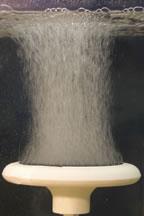Aerators and diffusers are used to increase the gas content of a liquid, typically oxygen in water. Diffusers are a specific type of aerator in which air is diffused through a surface and into the liquid itself. The name does not refer to the process of diffusion through the liquid.
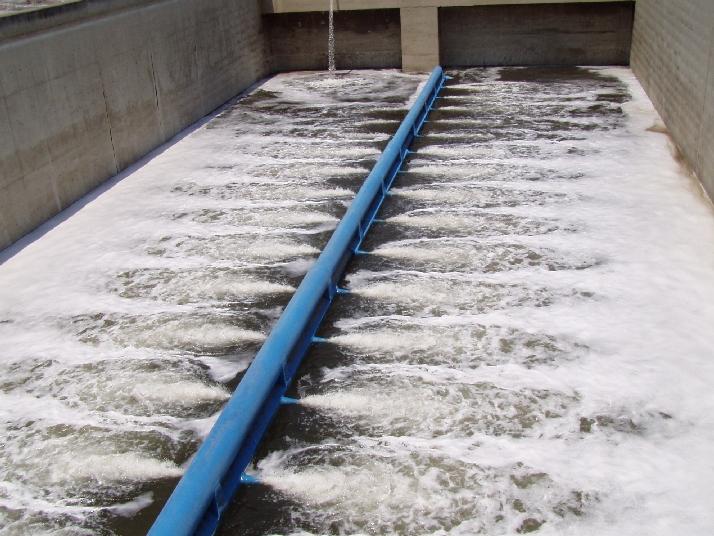
Aerators
Jet
These three jet aerators are used to aerate a circular tank, forming a clockwise flow pattern.

General Information
Jet aerators rely on a system of blowers to force air through the pipes and nozzles and pumps to pump liquid into the nozzle. The liquid is then injected inside the nozzle, and the mixture is sprayed into the tank, as shown below.
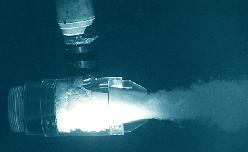
Equipment Design
Air is compressed using blowers and forced through a pipe. The liquid is also pumped through a separate pipe, usually located above the air pipe. The high-pressure air then leaves the inner nozzle; the liquid is injected into the outer half of the nozzle, where primary mixing occurs. In this high-pressure region, air diffuses into the water. The mixing that occurs in the nozzle is shown below, as the liquid (blue) and air (tan) are mixed inside the nozzle, before being expelled into the bulk liquid solution. As the stream is pushed into the tank, more mixing occurs, allowing the gas to diffuse further into the tank.
The momentum of the air-water mixture leaving the outer nozzle forces the mixture out horizontally into the liquid solution. Further diffusion then takes place in this bulk liquid, as the air bubbles rise to the surface.
There are multiple designs for jet aerators depending on the desired outcome. For example, there are bidirectional jet aerators, like the one shown below to the left. These aerators have jet nozzles on both sides of the liquid header, allowing flow in both directions. These aerators are ideal for large circular or rectangular tanks and usually have a single header down the middle of the tank. Another example is a directional aerator, like the one shown below in the middle. These aerators have nozzles on one side and are typically placed on the walls of tanks. They can also be placed in series, forcing circular flow, like the picture at the beginning of this section. Finally, there are eddy jet aerators, which place the nozzles in a radial arrangement, like the picture below on the right. These are particularly suited for circular tanks.



Usage Examples
Jet aerators are often used to aerate large tanks. They can be used to aerate wastewater – both in wastewater treatment plants and in chemical plants and refineries. The three bidirectional jet aerators shown below are being used by a food manufacturer to aerate a lagoon.

Advantages
- Suitable for a wide range of tanks and applications.
- The arrangement of nozzles permits the formation of current if desired.
- Larger jet aerator nozzles aren’t susceptible to fouling.
Disadvantages
- Require installation of blowers and piping
- Require an additional pumping system for the injected liquid.
- Fouling is still a problem with smaller nozzles or particularly dirty liquids.
Mechanical
Mechanical aerators are used to simultaneously aerate and mix a liquid. The mechanical aerator shown here floats on three pontoons.
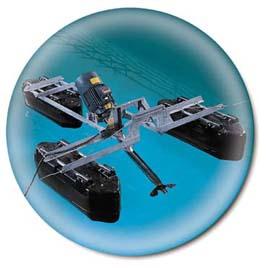
General Information
Mechanical aerators are also called mechanical surface aerators because they have moving parts — either a propeller or impeller and usually float on the liquid’s surface. Because of this, they are preferred for aeration, where some mixing is also desired. They usually are self-contained and the floating surface aerators are often only held in place by a string tied to the shoreline or the edge of the tank, as shown here.
Equipment Design
The propeller in this mechanical aerator churns the water rapidly, creating a vacuum. Air from above the surface is then drawn through the hollow tube to which the propeller is attached. The air is then pushed by the propeller into the main body of water.
Usually, the nozzles on mechanical aerators can adjust the angle at which the spray is aimed. By angling the nozzle vertically down, aeration is directed towards the bottom, limiting horizontal aeration. Similarly, by aiming the nozzle nearly horizontally, mechanical aerators can be used in shallow areas. This also creates a horizontal mixing pattern. The diagram below shows how the aerator, also shown, works.
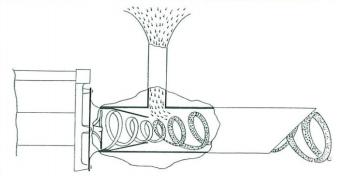

Shown below is another example of a mechanical surface aerator. This aerator uses an impeller to mix and aerate and is commonly used in oxidation ditches for wastewater treatment.
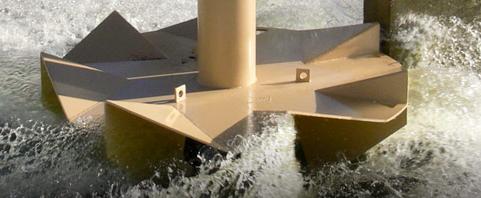
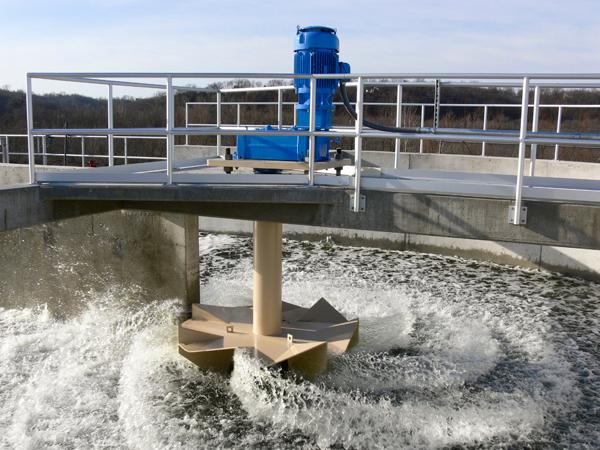
The lagoon shown below uses a combination of vertical aerators for deeper aeration in the center of the tank, and strategically placed horizontal aerators to mix the water on the perimeter of the tank. These horizontal mixers also create a clockwise current.
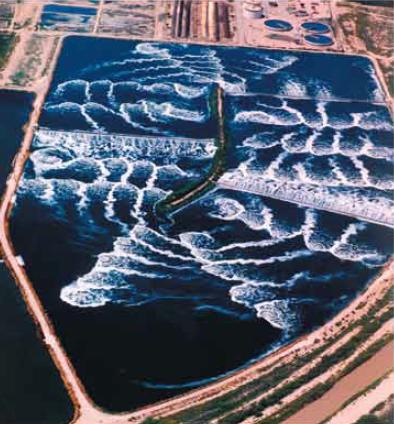
Usage Examples
Since mechanical aerators float on the surface, they don’t require a piping and blower system. Therefore, they are ideal for processes requiring temporary aeration, or for situations in which installation of a piping and blower system would be uneconomical. Shown below is a research and development testing pool that is used to analyze different aeration equipment.

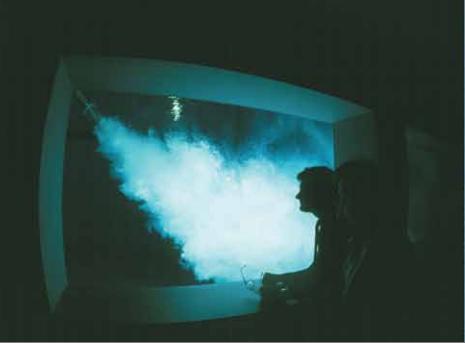
Advantages
- Don’t require additional blowers, pumps, or pipes — easy installation and removal.
- Provides excellent mixing profile.
- Nozzles can be adjusted for horizontal range or vertical depth.
Disadvantages
- Not as efficient as other aerators due to mechanical energy losses.
- Not as effective as diffusion methods.
Surface
Surface aerators, such as the one shown here, are used in shallow areas.

General Information
Surface aerators, also called falling film aerators can take many forms. They occur naturally in the form of waterfalls and river rapids. Artificial surface aerators are either fountains (left) or paddlewheels (right).
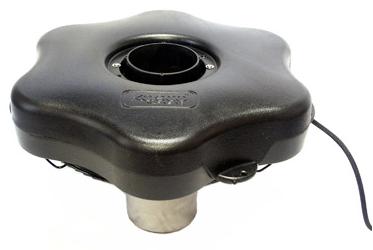
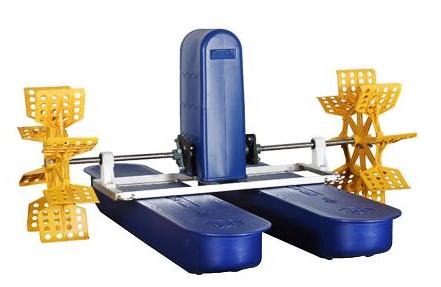
Surface aerators are the least efficient type of aerator. Although they don’t aerate as deeply as other aerators, they are much more aesthetically pleasing.
Equipment Design
Surface aerators work by “throwing” the liquid into the air. The drops of water then absorb oxygen as they fly through the air. The falling water’s momentum usually drives it below the water’s surface. As the waterfalls, the momentum also traps small air bubbles, which are also forced under the water’s surface, resulting in further aeration.
Surface aerators have a few benefits beyond aeration. Depending on the type of fountain, the momentum of the falling water also causes some mixing of the liquid. Because the water is thrown up into the air, fountains often serve to cool the water.

Usage Examples
Surface aerators are usually used in non-industrial applications. They can be used in hatcheries and other fish ponds to keep the water clean and oxygenate the water for the fish. They are also used in golf courses and metropolitan settings, as shown below, to aerate the water, keeping it clean and algae-free.
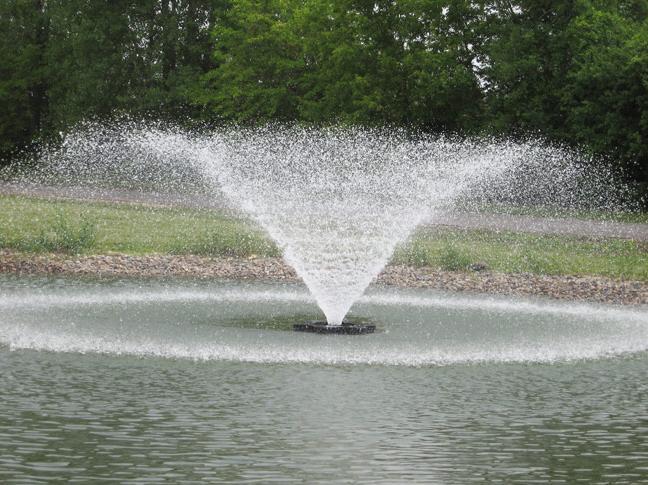
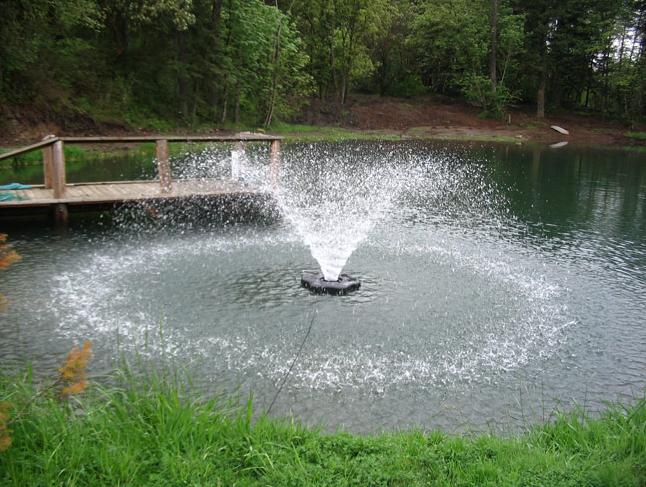
While not common in industrial areas, fountain aerators are sometimes used in industry, such as in pulp mills. The wastewater in such a mill must be aerated and cooled, making fountains the ideal choice.
Advantages
- Don’t require additional blowers, pumps, or pipes — easy installation and removal.
- Aesthetically pleasing for residential locations, golf courses, etc.
- Fountains can be used to cool water while aerating.
- Can be installed in extremely shallow water.
Disadvantages
- Not an efficient aeration method due to mechanical energy losses.
- Surface aeration is not as effective as diffusion methods.
- Doesn’t provide aeration to deeper bodies of water.
Diffusers
Disc and Dome
Disc and dome diffusers vary only in the curvature of their surface and work nearly identically.
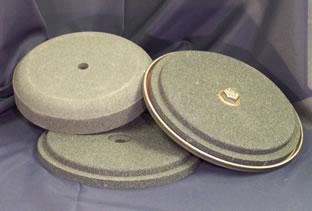
General Information
Disc diffusers are usually made of a porous ceramic or plastic material through which air diffuses. They are connected to a system of pipes on the bottom of an aeration tank, and a blower is used to compress air through the pipes.
Dome diffusers, such as the one shown here, vary from disc diffusers only in the curvature of their surface.
Equipment Design
A powerful blower (not shown) is needed to push air through the piping grid of disc/dome diffusers. Air is then allowed to diffuse through regularly spaced diffusers, as depicted in this animation.
The size of the pores affects the size of the bubbles created. Due to their smaller size, fine bubbles diffuse into the surrounding liquid faster than the larger, coarse bubbles.
Because fouling can be a problem, periodic maintenance is required, including an acid bath to clear pores. Fouling is the accumulation of unwanted buildup on an object’s surface. In this case, fouling could be algae, rust, or simply large biosolid particles. Some disc/dome systems are equipped with a built-in formic acid or anhydrous HCl delivery system that can be turned on while the system is in operation.
Disc/dome diffusers often require a complex grid of piping in order to provide a series of aeration zones. Because air bubbles rise straight up from the membrane surface, very little horizontal diffusion occurs. Therefore, a series of diffusers such as the ones shown below is required to ensure proper aeration throughout the tank.
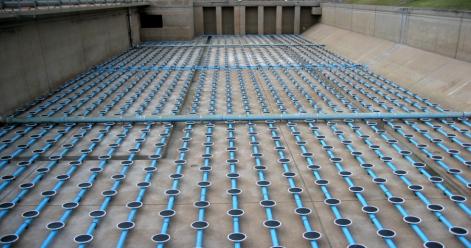
Usage Examples
Disc/dome diffusers are frequently used in areas requiring massive oxygen transfer. The disc diffusers shown below are designed to release 1-3 mm fine bubbles in a wastewater treatment plant.
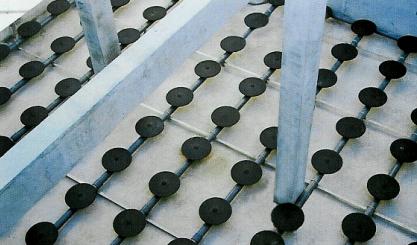
Aeration is one of the key steps in the treatment of wastewater. Bacteria are injected into the tank, where they aerobically digest organics and remove phosphorous from the water. Aeration is used to aid the digestion process.
Advantages
- Capable of fine or coarse diffusion.
- Provide an excellent vertical diffusion profile.
- More efficient operation than other diffusers.
Disadvantages
- Require an extensive system of piping to insure thorough aeration across the entire horizontal surface.
- Fine diffusers are highly susceptible to clogging.
- Require maintenance, including acid baths, to maintain optimal operation.
Tube
General Information/Equipment Design
Tube and plate diffusers are very similar to disc/dome diffusers. Tube diffusers often create large bubbles like those of coarse diffusion and are typically made out of stainless steel or rubber.
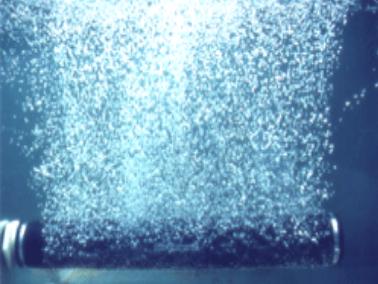
Usage Examples
Tube and plate diffusers are applicable anywhere disc/dome diffusers are. The tube diffusers pictured below are used in a wastewater treatment facility.
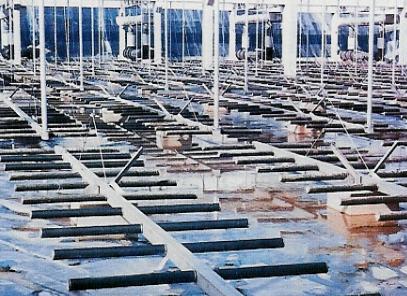
They are also used for small-scale applications, such as aerating fish tanks. Similar small-scale plate and tube diffusers are often used in hatcheries, or to keep bait alive for sport fishing.
The aerator shown below is used for ponds deeper than eight feet. It provides aeration without using electricity because it injects compressed air directly to the bottom of the pond.
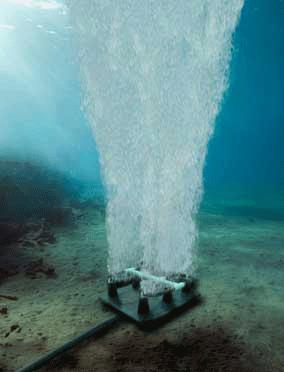
Advantages
- Easily added to existing apparatus.
- Less fouling and required maintenance than disc/dome diffusers.
Disadvantages
- Tube diffusers require a pipe and blower system and some maintenance to prevent fouling.
- Not capable of fine-pore diffusion, which has the highest transfer rate.
Plate
General Information/Equipment Design
Plate diffusers aren’t as popular today as they were in the past, due to problems achieving uniform air diffusion and difficulties in upgrading and adding to existing configurations. Plate diffusers are normally used today in smaller bodies of water. They are placed on the tank’s bottom, and usually, only one plate diffuser is connected to a small air compressor. Below to the right is an example of two plate diffusers connected together.

Usage Examples
Plate diffusers can be used anywhere disc/dome diffusers are used. In addition to being used in large-scale applications, they’re also used individually for smaller tanks. Two examples of large-scale applications of plate diffusers are shown below. To the left is an example of a fish farm in Europe that uses plate diffusers to add oxygen to the water. To the left is an example of a landfill lagoon used to treat leachates.

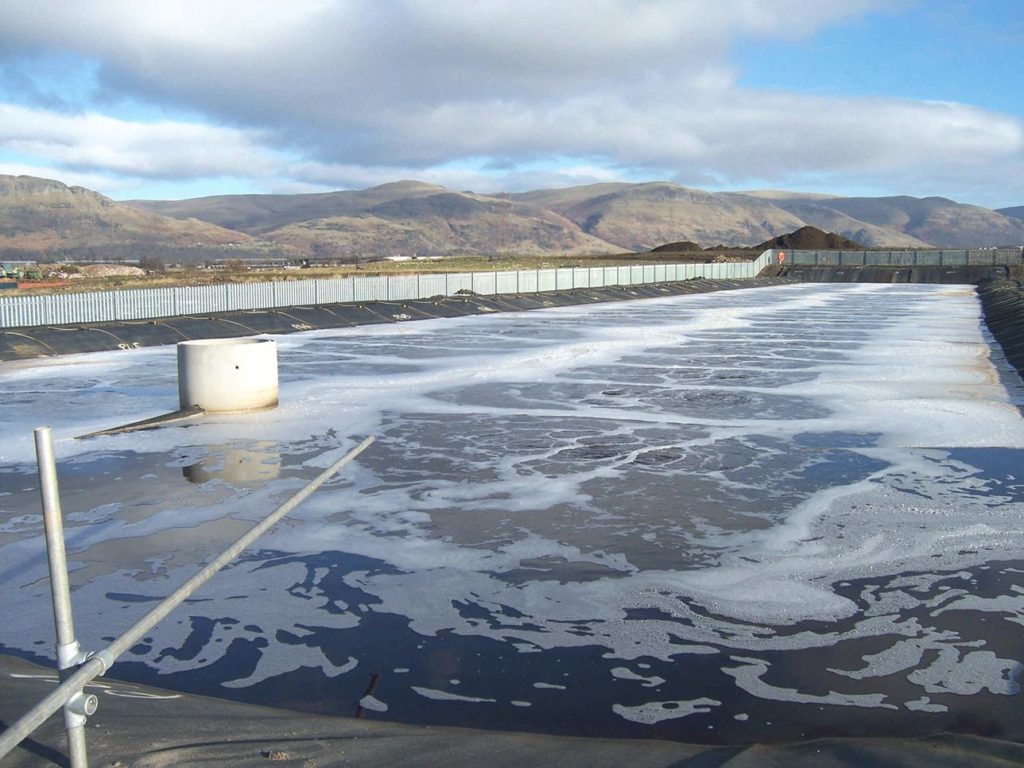
Advantages
- Easily added to existing apparatus.
- Less fouling and required maintenance than disc/dome diffusers.
- Capable of very fine diffusion.
Disadvantages
- Requires installation and blowers.
- Diffusion is uneven if multiple plates are linked to one blower.
Acknowledgments
- Aeration Industries International, Chaska, MN
- Airolator Corporation, Kansas City, MO
- Dryden Aqua Ltd, Edinburgh, Scotland
- Ecologix Technologies Asia Pacific, Inc.
- Filtros Ltd , East Rochester, NY
- Food and Agriculture Organization of the United Nations
- Mixing Systems, Inc., Dayton, OH
- WesTech, Inc., Salt Lake City, UT
References
- Boyle, W. C. et al . Fine Pore Aeration for Wastewater Treatment. Park Ridge, NJ: Noyes Data Corp, 1990. Print.
- Cheremisinoff, Paul N. “Aerators for Wastewater Treatment.” Pollution Engineering March 1974: 41-50. Print.
- Houck, Daniel H. “Design Considerations for Ceramic Fine Bubble Grid Diffuser Systems.” Water/Engineering and Management 132 July 31 1985: 8-13. Print.
- Houck, Daniel H. “Evaluating and Selecting Fine Bubble Diffusers.” Public Works January 1987: 67-70, 104. Print.
- Hunter, John Samuel. “A Basis for Aerator Design.” Diss. Colorado State University. 1977. Print.
- Perry, Robert H. and Don W. Green. Perry’s Chemical Engineers’ Handbook. 7th ed. New York: McGraw-Hill, 1997: 25-70 – 25-73. Print.
- Thomas, Neale. “Plunging Flow Aeration: Some Fundamental and Functional Factors” Aeration Technology. Ed. Roger E. A. Arndt and Andrea Prosperetti. New York: The American Society of Mechanical Engineers, 1994. 1-11. Print.
Developers
- Joseph Palazzolo
- Julie Messacar
- Steve Wesorick
- Kelsey Kaplan
- Keith Minbiole

